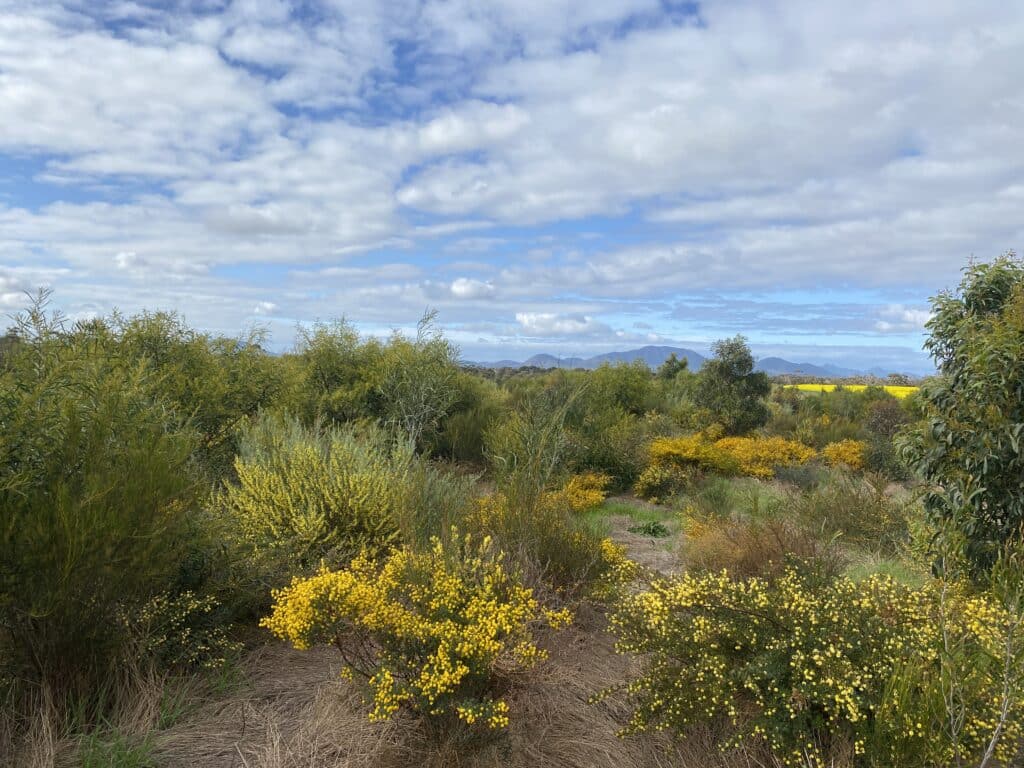Your Footprint. Australia’s Trees. Our Future.
Types of planting
“We are dedicated to using local suppliers for all our planting projects to keep money in the region and in the communities we serve. This is an essential part of the sustainability of our projects.” – Louise-Marlena Tarrier, CEO
Our approach to helping combat the impact of climate change is to plant trees and native vegetation to provide a carbon sink. Using nature as our guide we plan and deliver ecologically sensitive planting in partnership with landholders. Our planting primarily takes place on degraded, unused farmland and we restore the natural habitat by planting a mix of native trees and shrubs that are indigenous to the area.
We currently have three main types of planting projects: biodiverse carbon planting, saltland carbon planting, and biodiverse sandalwood planting.

Biodiverse carbon
Biodiverse carbon planting involves restoring the natural landscape by planting a range of native species that represent the flora found on the site prior to clearing.
Site preparation includes ripping with wide scalp lines in a meandering pattern, which mimics natural planting configurations. Ripping increases water retention and loosens the topsoil, which is essential for seed germination, root penetration, and plant survival. Scalping reduces weed competition, improving the chances of seedling survival and establishment.
A combination of direct seeding, hand-planting, and/or machine-planting techniques is used to revegetate the area.
The native species mix is specially designed for each site to reflect vegetation found in pre-European settlement.
The seedlings mix for a biodiverse carbon planting in Western Australia typically includes Eucalyptus, Acacia, Melaleuca, and Banksia species.
Native trees assist agricultural areas to be more sustainable by preventing salinity and soil erosion and providing shade, shelter, food, and habitat to native animals.
By planting what used to grow here, the hope is that these plants will establish and naturally regenerate to develop self-sustaining habitats and ecosystems.
Projects with biodiverse carbon planting
Saltland carbon
Saltland carbon planting refers to the restoration of salt-affected land using native, salt-tolerant species. Saline soil is more susceptible to soil erosion, water logging, and nutrient deficiencies than non-saline soil reducing the soil productivity and the biodiversity of the area.
A saltland carbon project involves extensive site preparation including ripping, scalping and mounding. Mounding is an important step which helps to reduce the risk of seedling roots being exposed to high salinity. It also helps to improve drainage to prevent waterlogging, as well as minimise weed competition improving the likelihood of seedling survival and establishment.
The species that are planted are specifically chosen for their biodiversity, salt tolerance, drought tolerance, and ability to survive in nutrient-poor soils. The key species include Atriplex, Casuarina, and Melaleuca.
We hope to demonstrate the possibility of converting low-productivity saline land into well-functioning land that supports native biodiversity and can be improved for water use, stock shelter, and mixed grazing in the future.
Projects with saltland carbon planting


Biodiverse sandalwood
Biodiverse sandalwood planting refers to the planting of sandalwood trees (Santalum spicatum) alongside other native plant species to create a natural and biodiverse landscape.
Prized for its aromatic oil and wood, Australian sandalwood once grew plentifully across Western Australia. In the 1840s, sandalwood was the state’s largest export earner, providing more than 30% of the total export income!
Sandalwood is a long-lived, slow-growing hemiparasite that is native to semi-arid and arid areas in southern and western Australia. As it is a hemiparasite, this means it needs other trees to act as a host for it to grow. We plant sandalwood alongside native host species such as Acacia (wattles) and Allocasuarina (sheoaks) at a ratio of 30:70.
To prepare the site for planting, the site is ripped and scalped to remove weeds from the seed bank and loosen the soil so seedling root establishment is successful and competition is minimised.
A biodiverse sandalwood planting involves a combination of direct seeding, hand-planted and/or machine-planted seedlings, and hand-sown sandalwood seeds.
This biodiverse planting method provides a range of benefits to the landscape including habitat for pollinators, birds, and other native species.
Once the sandalwood trees have reached maturity (around 25 years), the landowners can harvest the nuts and timber as a source of additional income from land that was compromised prior to planting. The remaining plants after harvest will continue to grow and help reduce wind erosion, improve soil health and increase biodiversity.
Projects with biodiverse sandalwood planting
Miyawaki MicroForests
The Miyawaki method of afforestation was developed by Professor Akira Miyawaki, a Japanese botanist and forest ecologist. This method has been adapted to an Australian context, and it involves careful native species selection, specific soil preparation, very dense planting, a high diversity of species planted, and the key ingredient of community involvement.
Miyawaki plantings require a minimum space of 3m2, can hold up to 30 different species, and become self-sufficient within 2-3 years after planting.
Site preparation is essential for their success, requiring rich organic matter to remediate the soil and provide enough essential nutrients for the tube stock to flourish.
The rich organic matter used is often prepped locally utilising food scraps from the local community and coffee grinds from local cafes to generate high-quality compost.
This circularity, alongside community planting days, fosters immense community ownership of these forests that ensures their success and longevity.
Our primary focus is to invest in their development in urban environments in order to combat urban heat temperatures and their impacts on vulnerable populations. Their ability to mature ten times faster than traditional reforestation methods makes them an invaluable community asset. This rapid growth allows for faster mitigation of climate change impacts and subsequently enhances local health and well-being.
Furthermore, supporting their implementation in schools offers a foundation for STEM education and fosters the development of systems training skills that nurture the environmental leadership of the next generation.
Projects using Miyawaki planting methodologies:

